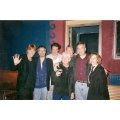
Artist: Cyril Neville
Title: Brand New Blues
Writer: Rick Galusha
Whether the Neville Brothers or the Marsalis’ are the first family of the New Orleans music community, both have a ready history of making fine music. And whether as solo artists, members of the Meters or recording together as, ‘The Neville Brothers,’ the Neville’s have , since 1954, made some highly listenable recordings including; ‘Fiyo on the Bayou,’ ‘Yellow Moon,’ and ‘Brothers Keeper.’
In the linear notes of his first solo album in eight years, Cyril Neville notes that Tab Benoit told him, “go blues” in 2005. While Cyril Neville’s album, ‘Brand New Blues’ may be his “blues record,” for me it is a more focused outing for the New Orleans native.
Often albums by the Neville Brothers include messages of social criticism. While the blues is usually personal, the outcry from New Orleans musicians over the 2005 flooding of New Orleans has been pervasive. On this record Neville delves elbow deep into the issue. In the linear notes writer John Sinclair tells readers that the flooding of New Orleans, “wasn’t really due to natural causes but was actually caused by the refusal of Congress to appropriate sufficient funding.” The actual finding, done in part by Louisiana State University, is, “Investigators criticized Congress for years of irregular funding and state and local authorities for failing to maintain the levees properly.” Sinclair goes on to say the flood was, “merely a trigger for institutional racism and civic ugliness.” You may agree or disagree where the blame lies; or the extent of who holds how much blame, however as a source for anguish and therefore material, the flood of New Orleans is a contemporary catastrophe and is now a part of America’s ‘disaster songs lexicon.’
So let’s talk about the music. This is not a “great” album in that it will not be widely embraced by the blues listener base. Instead it is a very strong record by a known American artist that aficionados of New Orleans and/or niche areas of blues and roots music will greatly enjoy. What Cyril shows us is a refraction of how the textures of blues music can be amalgamated into other genres and sounds. The sense and feel of this album is immediately familiar and, after hearing this recording, fans of the Neville Brothers will better recognize how Cyril contributes to the overall sound of his, ‘family groove.’
Like nearly any recording based in the poly-rhythms of New Orleans, it’s hard to keep your toes from tapping and your feet from dancing. ‘Cream Them Beans,’ is the equivalent of a Crescent City 12 bar jam as Neville talks over the track while the band rollicks.
Traditional blues radio programmers will want to focus on the album’s closing track, a cover of Bob Marley’s, ‘Slave Driver’ (where Marley’s album title, ‘catch a fire’ is coined.) This is a slow, highly textured track with a languid, slow burn. (Interestingly, Severn’s latest R n’ B singer Charles Wilson covers Marley’s ‘Is this Love’ on his latest release, “Troubled Child.”) Neville adds to Marley’s composition as he sings, “When I first saw what happen to New Orleans, my blood ran cold. My people’s freedom bought and sold,” in what develops into a quarter by quarter review of the current state of the 3rd Coast’s finest city…in its current form.
This is a good album; a credible showcase but it needs the listener’s full focus and an understanding that Neville is going to use his music as a vehicle for political advocating and, at times, I just want to hear music.










